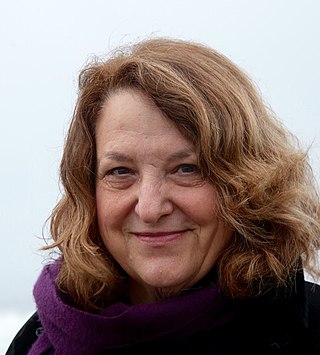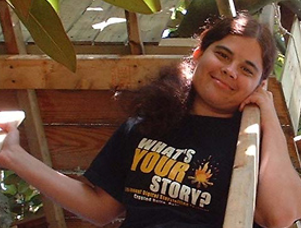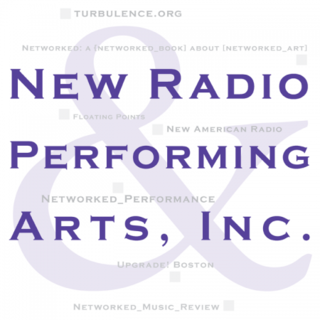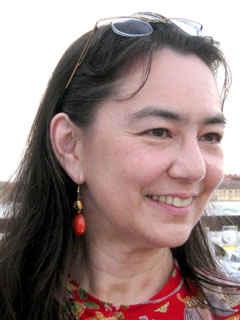Related Research Articles
Digital poetry is a form of electronic literature, displaying a wide range of approaches to poetry, with a prominent and crucial use of computers. Digital poetry can be available in form of CD-ROM, DVD, as installations in art galleries, in certain cases also recorded as digital video or films, as digital holograms, on the World Wide Web or Internet, and as mobile phone apps.

Lynn Hershman Leeson is a multimedia American artist and filmmaker. Her work combines art with social commentary, particularly on the relationship between people and technology. Leeson is a pioneer in new media, and her work with technology and in media-based practices helped legitimize digital art forms. Her interests include feminism, race, surveillance, and artificial intelligence and identity theft through algorithms and data tracking. She has been referred to as a "new media pioneer" for the prescient incorporation of new science and technologies in her work. She is based in San Francisco, California.

Internet art is a form of new media art distributed via the Internet. This form of art circumvents the traditional dominance of the physical gallery and museum system. In many cases, the viewer is drawn into some kind of interaction with the work of art. Artists working in this manner are sometimes referred to as net artists.

Deena Larsen is an American new media and hypertext fiction author involved in the creative electronic writing community since the 1980s. Her work has been published in online journals such as the Iowa Review Web, Cauldron and Net, frAme, inFLECT, and Blue Moon Review. Since May 2007, the Deena Larsen Collection of early electronic literature has been housed at the Maryland Institute for Technology in the Humanities.

New Radio and Performing Arts, Inc. (NRPA), and its satellite project Turbulence.org, was an American organization that commissioned and archived new and experimental radio art, sound art, net art and mixed reality art. It was founded in 1981 by Helen Thorington. In 2003, NRPA opened an office in Boston, Massachusetts. The organization closed in December 2017.
Irene Chan is an American visual artist known for her work in artist's books.

Tamiko Thiel is an American artist, known for her digital art. Her work often explores "the interplay of place, space, the body and cultural identity," and uses augmented reality (AR) as her platform. Thiel is based in Munich, Germany.
J. R. Carpenter is a British-Canadian artist, writer, and researcher working across performance, print, and digital media. She was born in Nova Scotia in 1972. She lived in Montreal from 1990 to 2009. She emigrated to England in 2010, and became a British citizen in 2019. She now lives in Southampton, England.

Jody Zellen is an American artist and educator. Her practice, consisting of digital art, painting, video art, and drawing, has been showcased by way of interactive installations, public art, and curated exhibitions. She is also known for her art criticism.
Annette Louise Barbier was an American artist and educator. She worked with video art, net art, installation art, interactive performance, and emerging and experimental technologies since the 1970s. Themes in her work address "issues of home, defined locally as domesticity and more broadly as the ways in which we relate to our environment." An early work, "Home Invasion [1995]," incorporating critical dialogue and audio, is accessible from Leonardo. "Domestic space—formerly inviolable—is increasingly disrupted by electronic communication of all sorts, including radio, TV, email and the telephone." She was Chicago-based.
Margaret Morse was an emerita professor at the University of California, Santa Cruz who taught film and video. She was also a well-versed author known for her critical analysis of both United States and European media artists. She had a propensity for closed-circuit video installations. Much of her work and career revolved around subjects in experimental film, video art, interactive Media and written works looking into our interaction with modern media and digital machines.
Virginia Barratt is an Australian researcher, artist, writer and performer. She is currently writing a PhD at Western Sydney University in the Writing and Society Centre. Barratt's doctoral research focuses on panic, affect and deterritorialization, explored through performance, experimental poetics and vocalities.
Tina Escaja, also known as Alm@ Pérez, is a Spanish-American writer, activist, feminist scholar and digital artist based in Burlington, Vermont. She is a Distinguished Professor of Romance Languages and Gender & Women's Studies, and the Director of the Gender, Sexuality and Women's Studies Program at the University of Vermont. She is the winner of the International Poetry Prize Dulce María Loynaz, and the National Latino Poetry Award for Young Adults, Isabel Campoy-Alma Flor Ada. She is considered a pioneer in the field of electronic literature in Spanish. She is a full member of the North American Academy of the Spanish Language (ANLE), and Corresponding member of the Royal Spanish Academy (RAE).
This is How You Will Die is an interactive digital poetry and art game created by Jason Nelson, a new media artist, digital poet, and lecturer. Released in 2005, the game combines elements of poetry, digital art, and chance-based mechanics to explore the concept of death and the unpredictability of life.
Generative literature is poetry or fiction that is automatically generated, often using computers. It is a genre of electronic literature, and also related to generative art.
haikU is a browser-based, audience participatory, haiku poem project. The project displays randomly generated haiku poems, and allows the Internet audience to contribute to the project's database of haiku lines. The project is known as a work of electronic literature and for its use of an evolving database, and for the relative coherence of its output. It was created by Nanette Wylde in 2001 and is considered a form of interactive digital poetry.
Storyland is a browser-based narrative work of electronic literature. The project is included in the first Electronic Literature Collection. It was created by Nanette Wylde in 2000 and is considered a form of Combinatory Narrative or Generative Poetry which is created with the use of the computer's random function.
Natalia Fedorova is a new media scholar, artist, and translator. Her works include avant-garde poetry, kinetic poetry, concrete poetry, hyperfiction, literary text generators and video poetry. Fedorova mainly focuses on electronic literature centered on Russia and how it functions in Russia. She is one of the most notable female contributors to electronic literature from Russia. She is the co-founder with Taras Mashtalir of the media poetry group Machine Libertine.
Meaning Maker is a conceptual, social practice art project by Kent Manske and Nanette Wylde. The project consists of ten questionnaires on a range of topics. It was initiated in 2006 by PreNeo Press. Meaning Maker has been exhibited in galleries, published in journals, is included in the RISD artists' book collection, and has been unofficially distributed and placed at numerous art events.
References
- 1 2 London, Sherry; Grossman, Rhoda (1994). Painter 5 F/x. Chapel Hill, NC: Ventana Press. p. 392. ISBN 978-1566045032.
- ↑ "Rhizome". Rhizome. 2011-02-04. Retrieved 2024-04-17.
- 1 2 "Nanette Wylde | ELMCIP". elmcip.net. Retrieved 2024-04-17.
- 1 2 "The fascinating world of book arts: 3 Bay Area makers share their stories". The Mercury News. 2023-01-16. Retrieved 2024-04-17.
- ↑ "August 2023". Books On Books. 2023-08-31. Retrieved 2024-04-17.
- ↑ "The NEXT Search Space". The NEXT. Retrieved 2024-04-17.
- ↑ "Stretcher | Features | Corporate Art Expo '07". www.stretcher.org. Retrieved 2024-04-17.
- ↑ staff, Palo Alto Weekly (2022-06-09). "Exhibit features one-of-a-kind prints inspired by nature". Palo Alto Online. Retrieved 2024-04-17.
- 1 2 Wylde, Nanette (2024). "Marrying Form and Concept in Conceptual Art". The California Printmaker: 33–35. ISSN 2769-7894.
- ↑ "Web Gallery | The de Young Open 2023". deyoungopen2023.artcall.org. Retrieved 2024-04-25.
- ↑ "PRINTERESTING · The thinking person's favorite online resource for interesting printmaking miscellany". web.archive.org. 2009-08-15. Retrieved 2024-04-17.
- 1 2 3 4 Wylde, Nanette (1996). A brief history... interactive multimedia art installation: discussion of process, media, content, and response (Thesis). The Ohio State University.
- 1 2 "Arts4All | Mountain View | Community School of Music & Arts". web.archive.org. 2022-03-03. Retrieved 2024-04-17.
- 1 2 3 4 5 "InterfaceNav3". web.archive.org. 2007-08-07. Retrieved 2024-04-17.
- ↑ "Participants". Extraction: Art on the Edge of the Abyss. Retrieved 2024-04-17.
- 1 2 Rettberg, Scott (2008). "Dada Redux: Elements of Dadaist Practice in Contemporary Electronic Literature". Fiberculture Journal (11). Digital Art & Culture Conference Perth.
- ↑ "Nanette Wylde – ISEA Symposium Archives". isea-archives.siggraph.org. Retrieved 2024-04-17.
- 1 2 "Nanette Wylde: About so many things – ISEA Symposium Archives". isea-archives.siggraph.org. Retrieved 2024-04-17.
- ↑ "Nanette". soundsrite.uws.edu.au. Retrieved 2024-04-17.
- ↑ "Rhizome". Rhizome. 2007-03-04. Retrieved 2024-04-17.
- ↑ "Rhizome". Rhizome. 2004-09-02. Retrieved 2024-04-17.
- ↑ "Storyland". The NEXT. Retrieved 2024-04-17.
- ↑ De Vries, Kim (2008). Infinite Transformations of Desire. Turlock, Ca: University Art Gallery. California State University Stanislaus.
- ↑ "Hello Catty! by Nanette Wylde". 23 Sandy. Retrieved 2024-04-17.
- ↑ "Cultural Spectacle Investigation: Las Vegas by Nanette Wylde and Kent Manske". 23 Sandy. Retrieved 2024-04-17.
- ↑ Democrat, Woodland Daily (2008-03-13). "Art Feature: "Meaning Matters" in playful university art exhibit". Daily Democrat. Retrieved 2024-04-17.
- ↑ "Foodies : seven West Coast foodie vignettes | WorldCat.org". search.worldcat.org. Retrieved 2024-04-17.
- 1 2 Manske, Kent; Wilde, Nanette; Press, PreNeo. Meaning Maker.
- ↑ Pelts, Sam (2020). Extraction : art on the edge of the abyss (1st ed.). Berkeley, CA: The CODEX Foundation. pp. 556–561. ISBN 9780996218474.
- ↑ correspondent, Nick Bradley Daily Journal (2020-03-07). "'You are the tree': Redwood City exhibit incorporates local business byproducts into commentary". San Mateo Daily Journal. Retrieved 2024-04-17.
- ↑ Kane, Karla (2020-02-19). "In new Redwood City artwork, the community is the tree". Palo Alto Online. Retrieved 2024-04-17.
- ↑ "English 589". writing.upenn.edu. Retrieved 2024-04-17.
- 1 2 "Storyland | ELMCIP". elmcip.net. Retrieved 2024-04-17.
- ↑ Abes, Cathy (1994). Photoshop F/x. Chapel Hill, NC: Ventana Press. p. 240. ISBN 9781566041799.
- ↑ Pacific, University of the (November 15, 2001). "Campus art center displays new artwork". The Pacifican: 1 – via JSTOR.
- 1 2 3 Guertin, Carolyn (2012). Digital Prohibition: Piracy and Authorship in New Media Art (1st ed.). New York, NY: Continuum. p. 4. ISBN 978-1441131904.
- 1 2 "Electronic Literature Collection Volume One". collection.eliterature.org. Retrieved 2024-04-17.
- ↑ "Small Plates Books | San Francisco Center for the Book". sfcb.org. Retrieved 2024-04-17.
- ↑ "Truth: Artist Books and Broadsides". GALLERY ROUTE ONE. Retrieved 2024-04-17.
- ↑ "Nanette Wylde". 23 Sandy. Retrieved 2024-04-17.
- ↑ "I will remember". FAMSF. Retrieved 2024-04-17.
- ↑ "Al-Mutanabbi Street Starts Here Artists' Books Collection, 2007-2015 | Rare Book & Manuscript Library | Columbia University Libraries Finding Aids". findingaids.library.columbia.edu. Retrieved 2024-04-17.
- 1 2 3 4 5 6 "10 amazing human inventions that I use almost daily and am truly grateful for | WorldCat.org". search.worldcat.org. Retrieved 2024-04-17.
- ↑ "I keep forgetting to breathe | WorldCat.org". search.worldcat.org. Retrieved 2024-04-17.
- 1 2 3 4 5 6 7 8 "Hello Catty! | WorldCat.org". search.worldcat.org. Retrieved 2024-04-17.
- ↑ "I keep forgetting to breathe - Cornell University Library Catalog". catalog.library.cornell.edu. Retrieved 2024-04-17.
- 1 2 3 4 5 "Foodies : seven West Coast foodie vignettes | WorldCat.org". search.worldcat.org. Retrieved 2024-04-17.
- ↑ Wylde, Nanette (2008). Gray matter gardening: how to weed your mind. San Francisco Center for the Book. San Francisco: Imprint of the San Francisco Center for the Book.
- ↑ "sonnet-27_web". The Conveyor. 2016-11-18. Retrieved 2024-04-17.
- ↑ "Sonnets 2016 – The Conveyor". 2017-10-27. Retrieved 2024-04-17.